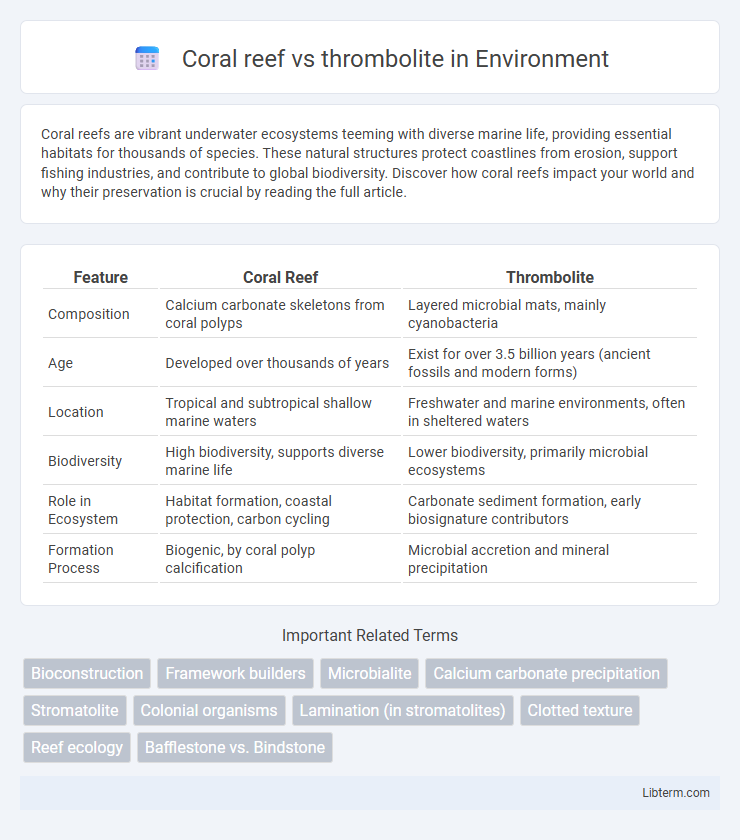Coral reefs are vibrant underwater ecosystems teeming with diverse marine life, providing essential habitats for thousands of species. These natural structures protect coastlines from erosion, support fishing industries, and contribute to global biodiversity. Discover how coral reefs impact your world and why their preservation is crucial by reading the full article.
Table of Comparison
| Feature | Coral Reef | Thrombolite |
|---|---|---|
| Composition | Calcium carbonate skeletons from coral polyps | Layered microbial mats, mainly cyanobacteria |
| Age | Developed over thousands of years | Exist for over 3.5 billion years (ancient fossils and modern forms) |
| Location | Tropical and subtropical shallow marine waters | Freshwater and marine environments, often in sheltered waters |
| Biodiversity | High biodiversity, supports diverse marine life | Lower biodiversity, primarily microbial ecosystems |
| Role in Ecosystem | Habitat formation, coastal protection, carbon cycling | Carbonate sediment formation, early biosignature contributors |
| Formation Process | Biogenic, by coral polyp calcification | Microbial accretion and mineral precipitation |
Introduction to Coral Reefs and Thrombolites
Coral reefs are diverse underwater ecosystems primarily formed by calcium carbonate secreted by coral polyps, hosting a vast array of marine life and contributing significantly to ocean biodiversity. Thrombolites, on the other hand, are clotted microbial structures created by the trapping, binding, and precipitation activities of microorganisms, primarily cyanobacteria, representing some of the oldest known ecosystems on Earth. Both coral reefs and thrombolites play crucial roles in marine environments, with coral reefs supporting complex habitats and thrombolites offering insights into early life and biogeochemical processes.
Geological Formation Processes
Coral reefs form primarily through the biological accumulation of calcium carbonate skeletons created by coral polyps, thriving in warm, shallow marine environments where photosynthetic algae facilitate rapid growth. Thrombolites develop as microbialites composed of clotted micritic carbonate, produced by cyanobacteria-induced mineral precipitation in shallow waters, often influenced by sediment trapping and binding. Unlike coral reefs, thrombolite formation is driven by abiotic and microbial interactions without the involvement of animal builders, reflecting distinct geochemical and environmental conditions.
Biological Composition and Diversity
Coral reefs are primarily composed of calcium carbonate secreted by coral polyps, hosting diverse symbiotic algae called zooxanthellae that support a rich marine ecosystem with thousands of species. Thrombolites consist of clotted microbial mats formed by cyanobacteria and other prokaryotes, showcasing microbial diversity rather than the complex eukaryotic organisms found in coral reefs. The key differences lie in coral reefs' complex animal-algal symbiosis driving high biodiversity versus thrombolites' simpler, microbially dominated biological composition.
Habitat and Environmental Requirements
Coral reefs thrive in warm, shallow, sunlit marine waters with stable salinity and temperatures between 23-29degC, predominantly found in tropical and subtropical regions. Thrombolites form in a wider range of environments, including hypersaline lakes, marine lagoons, and freshwater settings, often tolerating harsher conditions such as high alkalinity and temperature fluctuations. Both ecosystems rely on microbial communities but differ significantly in their habitat preferences and environmental resilience.
Structural Differences: Framework vs. Clotted Structure
Coral reefs exhibit a rigid, calcium carbonate framework built by the skeletal deposits of coral polyps, creating a highly organized and porous structure. In contrast, thrombolites possess a clotted, irregular structure formed by microbial communities, primarily cyanobacteria, which trap and bind sediment without a defined skeletal framework. This key structural difference highlights coral reefs as biologically constructed frameworks, while thrombolites represent biofilm-mediated sedimentary clots.
Ecosystem Services and Ecological Roles
Coral reefs provide critical ecosystem services including habitat for over 25% of marine species, coastal protection from storms and erosion, and support for fisheries generating billions in revenue annually. Thrombolites contribute by fostering microbial biodiversity, facilitating biogeochemical cycling, and serving as living records of early Earth conditions, thus supporting ancient microbial ecosystems. Both structures enhance nutrient cycling and carbon sequestration, but coral reefs play a more prominent role in supporting complex marine food webs and commercial fisheries.
Geographic Distribution and Locations
Coral reefs primarily thrive in tropical and subtropical ocean waters, with notable concentrations in the Indo-Pacific region, the Caribbean, and the Great Barrier Reef off Australia. Thrombolites are commonly found in specific shallow marine and lacustrine environments with hypersaline conditions, such as Shark Bay in Western Australia and certain alkaline lakes worldwide. Unlike coral reefs, thrombolites have a more limited and specialized geographic distribution tied to unique microbial activity and environmental factors.
Evolutionary History and Age
Coral reefs originated approximately 500 million years ago during the Cambrian period and reached their current diversity in the Mesozoic era, showcasing a complex evolutionary history tied to the rise of marine biodiversity. Thrombolites, older than coral reefs, date back over 3.5 billion years to the Precambrian, representing some of the Earth's earliest microbial life forms that contributed to oxygenation and early ecosystem development. While coral reefs are built by multicellular organisms with calcium carbonate skeletons, thrombolites consist of microbial communities that form clotted carbonate structures, marking significant evolutionary milestones in Earth's biosphere.
Threats and Conservation Challenges
Coral reefs face severe threats from climate change-induced ocean warming and acidification, leading to widespread bleaching and mortality, while thrombolites are endangered by water pollution, sedimentation, and habitat destruction. Conservation challenges for coral reefs include managing overfishing and coastal development, whereas thrombolite preservation requires maintaining specific water chemistry and low nutrient levels. Both ecosystems suffer from limited awareness and insufficient protected areas, complicating effective restoration and long-term survival efforts.
Scientific and Educational Significance
Coral reefs, formed by calcium carbonate-secreting corals, serve as biodiversity hotspots, supporting marine ecosystems and providing valuable data for climate change studies due to their sensitivity to environmental shifts. Thrombolites, ancient microbial structures made of mineralized microbial mats, offer a window into early life on Earth and the evolution of microbial communities over billions of years. Both formations contribute essential knowledge to paleontology, marine biology, and Earth sciences, enhancing educational curricula focused on Earth's biological and geological history.
Coral reef Infographic

 libterm.com
libterm.com